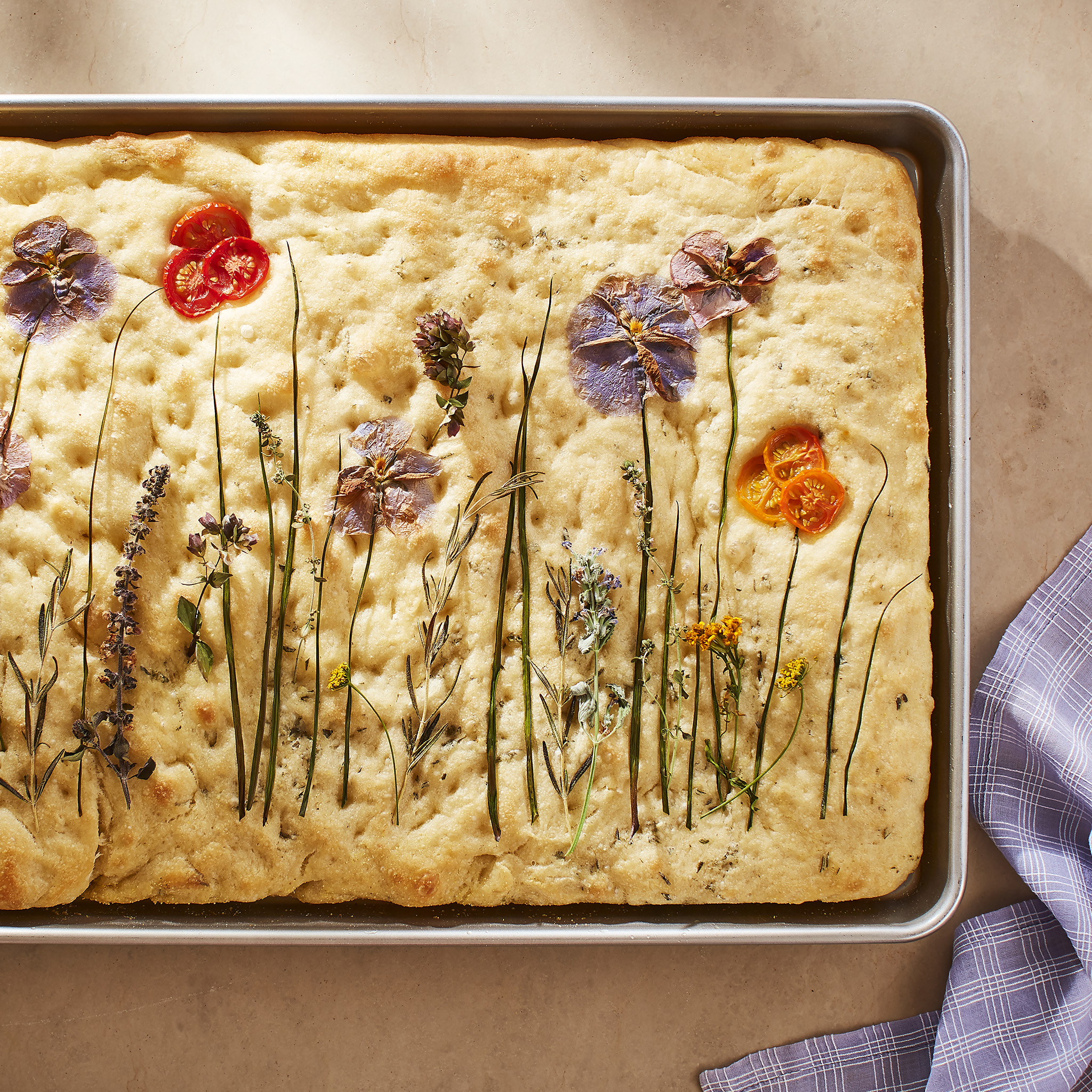Enjoy the final weeks of summer + shop our seasonal collection before we say so long. Find it here.
Set the tone with a fresh coat of paint. Shop Magnolia Home Paint.
This just in: a new season of Magnolia Table with Joanna Gaines. Learn more.

Herb Focaccia with Edible Flowers
Total 4 hours and 15 minutes (includes rising time)
Active 45 mins
Makes 6 to 8 servings
Making a pan of focaccia is one of quickest ways there is to get fresh bread on the table. And with a little creativity, your loaf can also be pretty enough to serve as a centerpiece. Once my dough has risen, and I’ve rolled it out and patted it out into a pan, I use edible flowers, vegetables, and herbs to make a kind of nature-inspired mosaic on the surface that bakes into a beautiful, flavorful topping.
TIP: While I prefer to use bread flour to make focaccia, because it helps the dough rise, you can also easily swap in all-purpose flour. If you don’t have a warm spot in your home to help the dough rise, you can turn your oven to low and leave the bowl on the stove.
Special Equipment
a high-sided rimmed baking sheet or regular rimmed baking sheet
Special Equipment
a high-sided rimmed baking sheet or regular rimmed baking sheet
Ingredients
Directions
- In a medium bowl, mix the yeast with 2 cups of lukewarm water and set it aside so that the yeast disintegrates into the liquid and turns foamy, about 5 minutes.
- In a stand mixer fitted with the dough hook, combine the bread flour, semolina flour, salt, and sugar with 1/4 cup of the olive oil. (Alternatively, combine the ingredients in a large mixing bowl for mixing by hand.) Run the mixer on low speed, stopping to scrape down the sides of the bowl occasionally, until the ingredients are well mixed, about 2 minutes. With the mixer running, slowly pour in the yeast mixture. Increase the speed to medium-high and continue running the mixer until the dough has come together in a springy mass and pulls away from the sides of the bowl completely, at least 10 to 15 minutes. (To mix by hand, stir the ingredients together with a wooden spoon, then knead the dough until it holds together well; it’s alright if the dough's a little bit sticky.)
- Add the rosemary and thyme to the dough and mix (or stir) briefly to combine. Turn out the dough onto a heavily floured surface, knead it a few times by hand, and form it into a ball. Grease a large bowl with olive oil, set the dough in the bowl (turning it a few times, so it has oil on its surface), and cover the bowl with plastic wrap or a kitchen towel. Set the dough in a warm spot to rise until it has doubled in size and feels puffy and light, about 1 to 3 hours depending on your kitchen temperature (see Cook's Note).
- When the dough has risen, use 2 tablespoons of the remaining olive oil to generously oil a high-sided (or regular) rimmed baking sheet, then generously dust the pan with the cornmeal. On a floured work surface, gently roll out the dough with a rolling pin until it is about the size of the inside of the pan. Transfer the dough to the pan and press into the corners. (Alternatively, release the ball of dough directly into the baking sheet. Gently press the dough with your fingertips until it reaches all corners of the pan in an even layer, stretching it as needed.) Cover the pan with a clean kitchen towel and set it aside to let the dough rise a bit, at least 10 minutes.
- Preheat the oven to 400°F. Use your fingertips to make small indentations all over the surface of the risen dough. Pour the remaining 1/4 cup of olive oil over the surface of the dough, then sprinkle on the Parmesan. Generously season the focaccia with salt.
- Use the chives, vegetables, and flowers to create a garden scene on the surface of the focaccia: The chives work well as stems, and you can top them with flower blossoms and petals as well as sliced olives and halved tomatoes.
- Bake the focaccia until the top is golden brown, about 20 minutes.